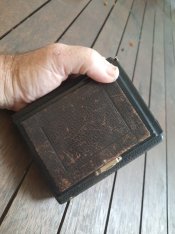I think John's idea of exposing it wet an extremely good one and it could bring the needed exposure down into "few hours" range, or even less than that!
For a completely different process, I tried making in-camera exposures of just the FAC mixed w/ a just a little gelatin ( and possibly a touch of CA to get the pH down to where FAC is most light-sensitive, I can't remember now ). I remember the weather was warm, it was probably Summer, and I tried exposures of around 6 to 8 hours in a 5x7 camera in full sun with an un-coated lens at F-2ish. After a few tries I gave up and decided to order some FAO to mix in ( Sandy King found a mixture of FAC and FAO to be a little faster in his "backward exposed" ferric gelatin prints ). Never got back to it, but I remember thinking the exposures were taking so long that I was running into trouble with the air oxidizing the ferrous back to ferric, so I was fighting a losing battle. I have no idea if this would happen with cyanotype ( reverting to ferric ) but it sounds like it's less of a problem since people have managed to make multi-hour/day exposures.
Either way, it might help to place the damp cyanotype paper between two thin sheets of glass in order to keep it damp and exclude oxygen. I've definitely seen with my own eyes that if you put something wet onto cyanotype paper, or if there are areas that are still slightly damp from coating, the exposure is very fast.
And, thank you very much for posting this. The FAO is here and I never continued the experiments... and that would make a great project for this summer. Also now you've got me thinking.... once the gelatin dries, it becomes insoluble, so it might be possible to speed up the process I was working on by dampening the paper underneath it and exposing between two sheets of glass... that's actually a fantastic idea. ( my goal was an in-camera positive process not using dichromate.. I was able to make positive contact prints in full sun with it, but it was too slow for in-camera )









